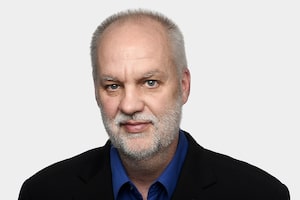From left: Adeeba Kamarulzaman, president of the International AIDS Society; Winnie Byanyima, executive director of UNAIDS; John Nkengasong, U.S. Global AIDS Coordinator; and Andriy Klepikov, director of the Ukrainian Alliance for Public Health, take part in news conference in Montreal on July 27.Ryan Remiorz/The Canadian Press
In the shadow of COVID-19, HIV-AIDS, the deadliest pandemic since the Black Death, has slipped from the headlines, and fallen down the list of political and health priorities.
This week, thousands of delegates will gather in Montreal for the 24th International AIDS Conference hoping to reverse that trend, and rekindle the pledge to end AIDS by 2030 – half a century after the new virus emerged.
“We can end AIDS by 2030, as promised,” said Winnie Byanyima, the executive director of UNAIDS. “But what it takes is courage.”
In a new report, In Danger, UNAIDS warns that the HIV response is faltering, and if that continues the result could be millions of new deaths.
Opinion: The global AIDS response is faltering, putting millions of lives in danger
But the news is not all dire. In some ways, the disinterest in HIV-AIDS stems from the success of public health in reining in the once out-of-control spread of the virus.
HIV infections and AIDS deaths have been falling steadily for many years.
Last year, there were 650,000 AIDS deaths globally – about one every minute. That number is down considerably from a peak of two million deaths in 2004, and half the number of a decade ago.
(By comparison, there were about two million COVID-19 deaths worldwide in 2020, and 3.5 million in 2021.)
An estimated 1.5 million people were infected with HIV last year, less than half the record 3.2 million new cases recorded in 2006. But still too many.
In Canada, there are about 62,000 people living with HIV, and 1,500 new infections annually. Thanks to widespread treatment, there are now about 135 deaths annually. AIDS patients are now dying of conditions of aging like cardiovascular disease and cancer.
The global drop in cases and deaths is attributable largely to access to antiretroviral therapy – cocktails of drugs that block the replication of the virus. ART prevents people from getting sick. Used appropriately, it can also prevent infected people from passing on HIV to others, as illustrated by the popular slogan U=U (undetectable=untransmittable).
An astonishing 28.7 million people accessed ART in 2021 – almost three in four people living with HIV worldwide. That number has grown four-fold in a decade. But 10 million people are still untreated, opportunity lost.
Despite all the attention afforded COVID-19, it remains that more than 40.1 million people have died of AIDS, and another 38.4 million are living with HIV.
Despite 40 years of dogged scientific research, there is no HIV vaccine and there is no cure.
At the Montreal conference, delegates will hear of glimmers of hope on both fronts, and about the need to re-engage the science.
COVID-19 vaccines, manufactured using novel mRNA technology, have provided a shot in the arm for stalled attempts to create an AIDS vaccine. There are new reports too of two more HIV patients being cured – a 66-year-old California man treated and a Spanish woman in her 70s.
Still, to date, there are only five known cases of patients cured of AIDS – out of 84.2 million infections.
The discussion at the 24th International AIDS Conference will be a mix of the scientific, social and political, with much of it revolving around the fact that inequality is what is fueling the pandemic, and COVID-19 related “disruptions” are making the situation worse.
New infections disproportionately affect the marginalized.
Young women and adolescent girls are three times more like to be infected with HIV as young men and adolescent boys. Men who have sex with men are 28 times more likely to be infected than men who have sex with women; intravenous drug users 35 times more likely; sex workers 30 times and; transgender women 14 times.
Stigma, discrimination and criminalization often prevent members of high-risk groups from seeking care and participating in prevention programs.
Combating a pandemic, as we have learned brutally in recent years, is costly. That is as true with HIV as COVID.
Low- and middle-income countries will need an estimated US$29-billion to tackle HIV through 2025, but face a shortfall of about $8-billion, according to UNAIDS estimates.
But the cost of inaction is even higher. It will be counted in millions of lives lost.
Our Morning Update and Evening Update newsletters are written by Globe editors, giving you a concise summary of the day’s most important headlines. Sign up today.
 André Picard
André Picard